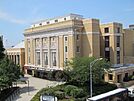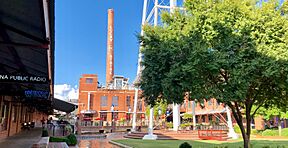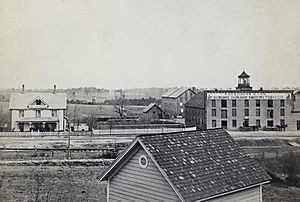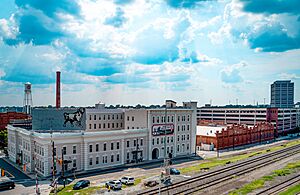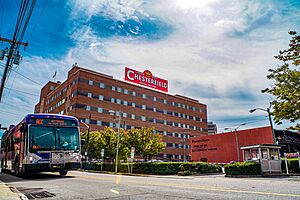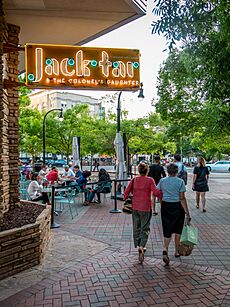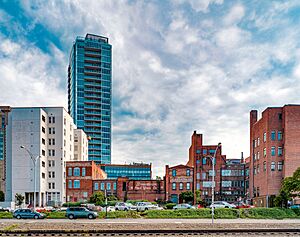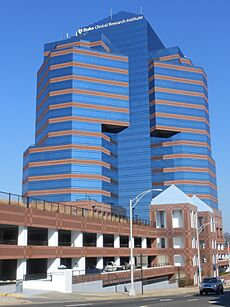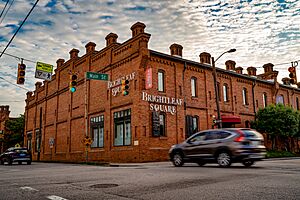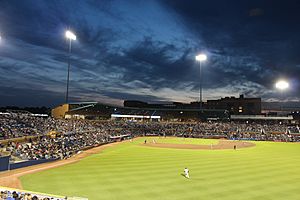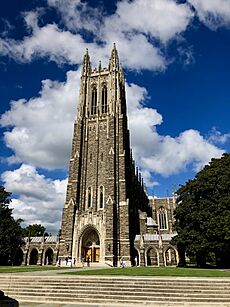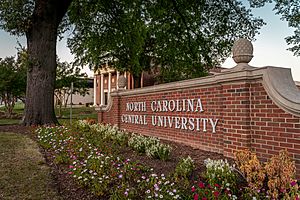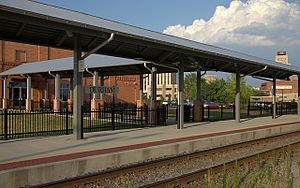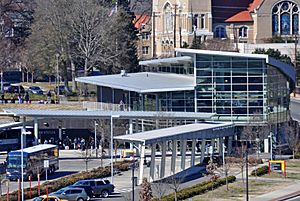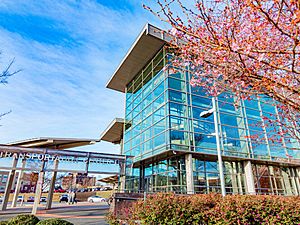Durham, North Carolina facts for kids
Quick facts for kids
Durham
|
|||||
|---|---|---|---|---|---|
|
Durham skyline
Carolina Theatre
American Tobacco Historic District
|
|||||
|
|||||
| Nickname(s):
Bull City, City of Medicine
|
|||||
| Country | United States | ||||
| State | North Carolina | ||||
| Counties | Durham, Wake, Orange | ||||
| Incorporated | April 10, 1869 | ||||
| Named for | Bartlett S. Durham | ||||
| Government | |||||
| • Type | Council–manager | ||||
| • Body | Durham City Council | ||||
| Area | |||||
| • Total | 116.19 sq mi (300.92 km2) | ||||
| • Land | 115.36 sq mi (298.79 km2) | ||||
| • Water | 0.82 sq mi (2.13 km2) 0.71% | ||||
| Elevation | 404 ft (123 m) | ||||
| Population
(2020)
|
|||||
| • Total | 283,506 | ||||
| • Estimate
(2023)
|
296,186 | ||||
| • Rank | 70th in the United States 4th in North Carolina |
||||
| • Density | 2,457.51/sq mi (948.85/km2) | ||||
| • Urban | 396,118 (US: 106th) | ||||
| • Urban density | 2,160.4/sq mi (834.1/km2) | ||||
| • Metro | 608,879 (US: 94th) | ||||
| Demonym(s) | Durhamite | ||||
| Time zone | UTC−5 (EST) | ||||
| • Summer (DST) | UTC−4 (EDT) | ||||
| ZIP codes |
27701, 27702, 27703, 27704, 27705, 27706, 27707, 27708, 27709, 27710, 27711, 27712, 27713, 27715, 27717, 27722
|
||||
| Area code(s) | 919, 984 | ||||
| FIPS code | 37-19000 | ||||
| GNIS feature ID | 2403521 | ||||
| Primary Airport | Raleigh–Durham International Airport | ||||
| Public transportation | GoDurham | ||||
Durham is a city in North Carolina, a state in the United States. It is the main town of Durham County. Parts of the city also reach into Orange County and Wake County. In 2020, Durham had about 283,506 people. This makes it the fourth-largest city in North Carolina. It is also the 70th largest city in the whole U.S.
The city is in the east-central part of the Piedmont region, which is an area of rolling hills. The Eno River flows through it. Durham is the center of a larger area called the Durham–Chapel Hill metropolitan area. This area had about 608,879 people in 2023. Durham is also part of the Raleigh–Durham–Cary, NC Combined Statistical Area, known as the Research Triangle. This bigger area had about 2.3 million people in 2023.
Durham started as a train stop in 1849. The land was given by Bartlett S. Durham, who the city is named after. After the American Civil War, Durham grew very quickly. This was mainly because of the tobacco industry. The town officially became a city in April 1869. Later, in 1881, Durham County was created. Durham became famous as the home of the American Tobacco Company. Other industries like textile and electric power were also important. Today, these older industries are not as big. Durham has changed and grown into a major center for education, medicine, and research.
Durham has several well-known universities. The most famous are Duke University and North Carolina Central University. The city is also a leader in health care. This is thanks to the Duke University Hospital and many health companies. Duke University and its health system are the biggest employers in Durham. North Carolina Central University is a historically black university, which means it was founded to educate African Americans. It is part of the University of North Carolina System. These two universities make Durham one of the three main points of the Research Triangle area. The Research Triangle Park is a large area south of Durham with many research facilities.
On the Duke University campus, you can see the Duke Chapel, which looks like an old Gothic building. You can also visit the Nasher Museum of Art. Other cool places in Durham include the Museum of Life and Science, the Durham Performing Arts Center, the Carolina Theatre, and the Duke Homestead and Tobacco Factory. Bennett Place marks the spot where two important generals, Joseph E. Johnston and William T. Sherman, met at the end of the American Civil War. The city shares the Raleigh–Durham International Airport with Raleigh.
Contents
History of Durham
Early Days and Native Americans
Long ago, the Eno and Occoneechi tribes lived in this area. They were related to the Sioux people. They might have had a village called Adshusheer. A path used for trading, called the Occaneechi Path, went through this land. Native Americans built villages and trade routes here.
In 1701, an English explorer named John Lawson explored the area. He called it "the flower of the Carolinas." In the mid-1700s, settlers from Scotland, Ireland, and England moved here. They built farms and mills, like West Point Mill.
Before the American Revolutionary War, some local people joined the Regulator Movement. This group protested against unfair taxes and government. During the Revolutionary War, a local farmer named William Johnston helped the American soldiers. He made weapons and supported Daniel Boone's explorations.
How Durham Started
Before the railroad came, Durham was mostly farmland. There were a few businesses for travelers on the Hillsborough Road. This road was a main route across North Carolina. As more people moved in, a U.S. Post Office was needed.
In 1849, a train station was built. It was on land given by Bartlett S. Durham, a doctor. The station was named after him. A post office opened there on April 26, 1853. This date is now seen as the city's official birthday.
The train stop, called Durham Station, was quiet at first. But in April 1865, during the American Civil War, things changed. The Federal Army, led by General William T. Sherman, came through. The last big Confederate Army, led by General Joseph E. Johnston, was nearby. The two generals met at Bennett Place, a farm near Durham Station, to talk about peace.
As soldiers from both armies passed through, they discovered the local tobacco. It was a mild type called Brightleaf tobacco. They liked it more than what they had at home. After the war, many soldiers wanted more of this tobacco.
Tobacco Brings Growth
Durham Station grew quickly after the Civil War. This was mostly because of the tobacco business. People started sending letters to John Ruffin Green's tobacco company. They wanted more of the Durham tobacco. W.T. Blackwell joined Green, and they named their company the "Bull Durham Tobacco Factory." The "Bull Durham" name came from a bull on a mustard jar. Mr. Blackwell thought the mustard was made in Durham, England.
As Durham Station grew, it became a town. It was officially made a town on April 10, 1869. It was named after Dr. Bartlett Durham. At first, Durham was part of Orange County. But it was a long trip to the county seat in Hillsborough. So, in 1881, Durham County was created. It was made from parts of Orange County and Wake County.
Durham's Early Success
The success of the Bull Durham Tobacco Company and Washington Duke's W. Duke & Sons Tobacco Company made Durham grow fast. Rich business owners built large homes. Washington Duke's sons were very smart. By 1900, they had almost complete control of the tobacco business in the U.S. Later, the government made them break up their company. The Duke family kept a big part, which became American Tobacco. This company kept making tobacco in Durham.
The Duke family also invested in a new industry: electric power. They built hydroelectric dams and brought electricity to many towns. This was a big deal because most towns only had small, smoky power plants. Duke Power also ran Durham's public transportation system until 1991.
Textile mills also came to Durham. They used the new electricity and hired many workers from nearby farms. These mills helped Durham's population double. Areas like East Durham and West Durham became part of the city.
In 1914, a huge fire destroyed much of downtown Durham. The city's water system failed during the fire. After that, people voted to have a city-owned water system.
Durham also developed a strong African-American community. The center was an area called Hayti. Here, some of the most successful black-owned businesses in the country started. These included the North Carolina Mutual Life Insurance Company and Mechanics & Farmers Bank. These businesses were on Parrish Street, known as "Black Wall Street." In 1910, Dr. James E. Shepard started North Carolina Central University. It was the first public college for African-Americans in the nation.
In 1924, James Buchanan Duke created a foundation to support Trinity College. The college then changed its name to Duke University. It built a large campus and hospital.
Changes in the Mid-1900s
Durham's factories started to decline in the mid-1900s. Textile mills closed, and tobacco sales went down. But in the late 1950s, Duke University, along with other universities, had a great idea. They convinced the state to create the Research Triangle Park. This was the first "science park" in the country. It brought many research companies to Durham. This new growth, along with Duke Medical Center, helped Durham recover.
Civil Rights Movement in Durham
Durham had a strong civil rights movement. Many African-American activists lived here. Martin Luther King Jr. visited the city. The Durham Committee on Negro Affairs, started in 1935, fought for voting rights for black people.
In 1957, Douglas E. Moore, a minister, helped start sit-ins in North Carolina. These protests were against places that only served white people. On June 23, 1957, Moore and six others went to the Royal Ice Cream Parlor. They sat in the whites-only booths. They were arrested for trespassing.
Three years later, similar sit-ins happened in Greensboro. Students from North Carolina College at Durham and Duke University also held sit-ins. Martin Luther King Jr. met Moore in Durham. King gave a famous speech at White Rock Baptist Church. He said, "Let us not fear going to jail." He encouraged people to protest peacefully.
Sadly, parts of the Hayti district were torn down in the 1960s. This was to build the Durham Freeway. Many historic buildings were lost.
Durham Today: A New Era
In the 1970s and 1980s, Durham started to grow again. New homes were built, especially near the Research Triangle Park. Downtown Durham also began to improve. In 1975, a group was formed to save the history of the old Hayti community.
In 1987, the American Tobacco Factory closed. This caused a tough time for Durham. But the city built a new baseball stadium for the Durham Bulls in 1994. The Durham Performing Arts Center also opened. It is now one of the top places for theater ticket sales in the U.S. Many famous performers have been there.
After the tobacco factories closed, many old buildings were made new again. They became offices, apartments, and restaurants. This helped bring life back to downtown Durham. Most of Durham's growth since 1990 has been in the southern part of the county.
Major employers in Durham today are Duke University and Duke Medical Center. They have about 39,000 employees. Companies in the Research Triangle Park have about 49,000 employees. These important places are connected by the Durham Freeway.
Downtown Durham's Comeback
In recent years, downtown Durham has become very lively. The city has worked with builders to fix up old tobacco buildings. The Durham Performing Arts Center and the new Durham Bulls Athletic Park helped a lot. The American Tobacco Historic District is a great example. It now has restaurants, entertainment, and offices for tech companies. Many other companies have also moved into renovated historic buildings.
The American Underground, part of the American Tobacco Campus, is home to many software companies. Google even chose it for a special event in 2013. A new building for the Durham County Justice Center opened in 2013.
Many old tobacco buildings have become cool loft apartments. West Main Street downtown has new bars, art studios, and shops. Brightleaf Square, another old tobacco warehouse, is also popular for shopping and dining. Future plans include expanding the American Tobacco Trail, building new hotels, and improving City Hall.
In 2013, a company announced plans to renovate the Hill Building. It would become a modern art museum, a fancy restaurant, and a hotel. In 2014, a big new project called the Durham Innovation District was announced. It will have offices, homes, and shops.
On April 10, 2019, a gas explosion happened at a coffee shop in the Bright Leaf Historic District. It destroyed a city block and caused injuries.
Geography of Durham
Durham is in the east-central part of the Piedmont region. This area has mostly flat land with some rolling hills. The city covers about 116 square miles. Most of this is land, with a small amount of water.
The soil here is mostly clay. This means it is not very good for farming. The Eno River flows through the northern part of Durham. Several small creeks also run through the city. The center of Durham is on a ridge. This ridge divides two river systems: the Neuse River and the Cape Fear River. A small part of Durham is in Wake County.
Durham is about 10 miles northeast of Chapel Hill. It is 21 miles northwest of Raleigh.
Durham's Climate
Durham has a humid subtropical climate. This means it has hot, humid summers. Winters are cool, and spring and autumn are warm. The city gets a lot of rain. Thunderstorms are common in the summer. Temperatures can reach 80 to 100 degrees Fahrenheit. Durham usually gets about 7 inches of snow each year. Any snow that falls usually melts in a few days.
If you have seasonal allergies, Durham can be a tough place to live. It often ranks as one of the most challenging places for allergies.
Climate change might bring more extreme rain to Durham. It could also make temperatures a bit warmer. More inland flooding is expected, especially for older people and those who are more at risk.
People of Durham (Demographics)
Durham's population has grown a lot over the years. In 1880, there were only about 2,041 people. By 2020, the population was 283,506. In 2023, it was estimated to be around 296,186.
In 2020, there were about 283,506 people living in Durham. There were 114,726 homes and 64,982 families.
In 2022, about 291,844 people lived in Durham. The city had about 124,536 households. The population density was about 2,499 people per square mile.
Here's a look at the different groups of people in Durham:
- White: 41.1%
- Black or African American: 34.7%
- Asian: 6.7%
- Native American or Alaskan Native: 0.6%
- Other races: 9.9%
- Two or more races: 7.1%
- Hispanic or Latino (of any race): 14.1%
About 24.3% of homes had children under 18. About 23.2% of homes had people 65 or older. The average age in Durham was 35 years old.
The average income for a household was about $78,105. For families, it was about $90,521. The average income per person was about $46,082. About 11.2% of people lived below the poverty line. This included 17.7% of children and 7.3% of seniors.
People in Durham come from many different backgrounds. Some of the most common ancestries include English, German, Irish, Italian, and American.
Economy of Durham
Duke University and Duke University Health System are the biggest employers in Durham. They provide many jobs.
Healthcare and medicine are very important industries here. Many companies in Durham work on health and medicine. These include GlaxoSmithKline, IQVIA, and Burt's Bees.
Other well-known companies based in Durham include Liggett Group (tobacco), North Carolina Mutual Life Insurance Company, and Mechanics and Farmers Bank.
Here are some of Durham's largest employers:
| Employer | Number of Employees |
|---|---|
| Duke University & Duke Univ. Health System | 34,863 |
| IBM | 10,000 |
| Durham Public Schools | 4,600 |
| GlaxoSmithKline | 3,700 |
| Blue Cross & Blue Shield of NC | 3,200 |
| City of Durham | 2,437 |
| Fidelity Investments | 2,400 |
| IQVIA | 2,400 |
| RTI International | 2,300 |
| Durham VA Medical Center | 2,162 |
| Cree | 2,125 |
| AW North Carolina | 2,000 |
Arts and Culture in Durham
Durham has many fun things to do. It hosts the annual Bull Durham Blues Festival. It also has the OUTsouth Queer Film Festival, which is the second largest LGBTQ+ film festival in the Southeast.
You can also find jazz festivals, plays, and art shows. The American Dance Festival and the Full Frame Documentary Film Festival are held here. The Carolina Theatre shows concerts, comedy, and movies.
Downtown Durham has many new restaurants. The Nasher Museum of Art opened in 2005. It shows art from all over the world.
The Museum of Durham History tells the story of the city. In 2019, it had an exhibit called "150 Faces of Durham." This showed people who helped shape the city.
The Durham Association for Downtown Arts (DADA) helps local artists. It supports different kinds of art and performances. DADA often offers free or low-cost events.
Movies like Bull Durham (1988) and The Handmaid's Tale (1989) were filmed in Durham.
Music Scene
Durham has a lively music scene. You can find many types of music, like jazz, hip-hop, soul, folk, and rock. Some popular musicians connected to Durham include Branford Marsalis, Iron & Wine, and Carolina Chocolate Drops.
Merge Records, a successful independent record label, is in downtown Durham. Other local labels also support artists. The roots music label Sugar Hill Records started in Durham.
Duke University has a radio station called WXDU. WNCU is another radio station that plays jazz music. It is supported by NPR.
The music album Sandham: Symphony Meets Classical Tamil was made with the Durham Symphony. It became a top seller on Amazon in 2020.
Durham has a rich history of African American rhythm and blues, soul, and funk music. Many groups recorded songs here in the 1960s and 1970s.
Since 1980, the Eno River Festival has been held every year. It features many different musical acts.
Visual Arts
Durham is home to the Nasher Museum of Art. It also has many smaller art galleries and studios. Every third Friday of the month, downtown Durham celebrates art and culture. This event is called 3rd Friday.
Some local galleries include Pleiades Gallery and the Carrack Modern Art. They show art from local and international artists. They often have weekly events. The Durham Art Walk is an annual festival in May. Artists show their work in the streets of Durham. The Durham School of the Arts is a high school in downtown Durham. It teaches students about visual and performing arts.
Sports in Durham
College sports are a big deal in Durham. The Duke University men's basketball team is very popular. Their home games at Cameron Indoor Stadium have been sold out since 1990. The fans are called the Cameron Crazies. They are known for their loud cheers. The team has won the NCAA Division I championship five times. Duke University has 27 sports teams that compete in the Atlantic Coast Conference.
Durham's professional sports team is the Durham Bulls International League baseball team. A movie called Bull Durham was made about an earlier team with the same name. Today's Bulls play at the Durham Bulls Athletic Park. This stadium was built in 1994. The Bulls are one of the most successful minor league teams. Many players from the Bulls have gone on to play in the major leagues. The old stadium, Durham Athletic Park (DAP), is still used for other teams and concerts. The DAP recently got a $5 million upgrade.
Education in Durham
Schools for Kids
Public schools in Durham are managed by Durham Public Schools. This is the eighth-largest school district in North Carolina. It has 46 public schools. These include elementary, middle, and high schools. Some high schools, like the Durham School of the Arts, focus on special subjects. Public schools in Durham were separated by race until 1970.
The North Carolina School for Science and Mathematics is a special high school. Students live at the school. It focuses on science, math, and technology.
There are also several charter schools. These include Research Triangle High School and Voyager Academy. Many private schools are in Durham too, such as Durham Academy. There are also religious schools, like Immaculata Catholic School.
Colleges and Universities
Duke University has about 14,000 students. Its campus and Medical Center are in western Durham. Duke is one of the three main points of the Research Triangle. The other two are the University of North Carolina at Chapel Hill and North Carolina State University.
North Carolina Central University (NCCU) is a public university in southeastern Durham. It was started in 1910 by James E. Shepard. It was created to help educate African Americans. NCCU offers many different degrees. It became a university in 1969.
Durham Technical Community College is a two-year public college. It offers associate degrees.
Media in Durham
The main daily newspaper in Durham is The Herald-Sun. It started in 1893. The Independent Weekly is a local newspaper known for its progressive views. It covers news and entertainment for the wider Research Triangle area. Duke University's student newspaper, The Chronicle, also covers local news.
Durham is part of a large TV market. WTVD, an ABC station, is based in Durham. UNC-TV, the state's public television service, has studios in Research Triangle Park. All major U.S. TV networks have channels that serve the region.
The city is also part of a large radio market. WUNC, an NPR station, has operations in Durham.
Transportation in Durham
Most people in Durham travel by car. Important roads include NC 147, which connects Duke University, downtown, and Research Triangle Park. U.S. 15-501 goes between Durham and Chapel Hill. I-85 connects Durham to other cities. I-40 runs through southern Durham County. This area has seen a lot of new businesses and homes since I-40 opened in the 1990s. Most people drive to work. About 14% of them carpool.
Durham has many bike routes and trails. It has won an award for being a Bicycle Friendly Community. The American Tobacco Trail starts downtown and goes south. The city is also working on a bigger bike trail system.
For air travel, people use Raleigh–Durham International Airport. It is about 12 miles southeast of Durham. Many flights go to major cities like Boston, New York, Chicago, and Atlanta. There are also international flights to London, Toronto, and Paris.
Amtrak trains stop in downtown Durham. The Carolinian train goes between Charlotte and New York City. The State of North Carolina also runs four daily Piedmont trains between Raleigh and Charlotte that stop in Durham. A new Amtrak station opened in 2011 in an old tobacco warehouse.
Some downtown streets cross the train tracks. One railroad underpass was famous for being too low. Many trucks hit their roofs there. In 2019, the track was raised to make it safer.
National bus service is available from Greyhound and Megabus. They use the Durham Transit Station, which opened in 2009. GoDurham provides local bus service.
GoTriangle offers bus service between Durham, Raleigh, Cary, and Chapel Hill. It also goes to the airport and Research Triangle Park. GoTriangle also helps people find carpools.
Duke University has its own bus system. Duke Transit runs over 30 buses around the campus and health system.
To make roads safer, Durham has a Pace Car Program. Drivers can join and agree to drive the speed limit. They also agree to stop at all stop signs and red lights. They stop for people crossing the street too.
Famous People from Durham
- Blind Boy Fuller (Fulton Allen), musician
- Louis Austin (1898–1971), journalist and civil rights leader
- Ernie Barnes, artist and painter
- Samuel Beam, singer/songwriter from Iron & Wine
- Ben Brantley, The New York Times theater critic
- Little Brother, hip-hop group
- Shirley Caesar, pastor and gospel singer
- Carolina Chocolate Drops, folk band
- Anthony Roth Costanzo, opera singer
- Roger Lee Craig, Major League Baseball pitcher and manager
- John Darnielle, musician from the Mountain Goats
- Betty Davis, funk and soul singer
- Reverend Gary Davis, musician
- The Duffer Brothers, creators of the Netflix series Stranger Things
- Benjamin Newton Duke, tobacco and energy businessman
- James Buchanan Duke, businessman, founder of Duke University
- Sylvan Esso, Grammy-nominated music duo
- Rapsody (Marlanna Evans), Grammy-nominated rapper
- Rick Ferrell, Major League Baseball player, in the National Baseball Hall of Fame
- Nnenna Freelon, jazz singer
- Philip Freelon (1953–2019), architect
- Penny Fuller, award-winning actress
- David Garrard, NFL quarterback
- David Gergen, advisor to U.S. presidents
- Jay Huff, professional basketball player
- Brandon Hargest, singer for Jump5
- Brittany Hargest, singer for Jump5
- Heather Havrilesky, author and humorist
- Biff Henderson, Late Show with David Letterman personality
- Big Daddy Kane, hip-hop artist
- John P. Kee, pastor and gospel singer
- Mike Krzyzewski, famous Duke basketball coach
- John D. Loudermilk, songwriter ("Tobacco Road")
- John Lucas II, NBA player and coach
- David Lynch, film director; lived in Durham as a child
- John Malachi, jazz pianist
- Leo Mangum, Major League Baseball pitcher
- Pigmeat Markham, comic actor
- Doug Marlette, Pulitzer Prize-winning cartoonist
- Branford Marsalis, jazz musician
- Tracy McGrady, NBA player
- Clyde McPhatter, singer, founding member of The Drifters
- LeRoi Moore of the Dave Matthews Band, musician
- Anita Morris, actress
- The Mountain Goats, indie rock band
- Pauli Murray (1910–1985), civil rights activist, attorney, and priest
- Link Neal, YouTuber with Rhett McLaughlin
- David Noel, NBA player
- Ike Opara, Major League Soccer player
- Robert Martin Patterson, U.S. Army soldier, Medal of Honor recipient
- Brian Roberts, Major League Baseball player
- Rodney Rogers, NBA player
- Don Schlitz, songwriter ("The Gambler")
- James E. Shepard (1875–1947), educator, founder of North Carolina Central University
- Jamie Stewart, musician from Xiu Xiu
- Andre Leon Talley (1948–2022), Vogue editor
- Grady Tate, musician and singer
- Jeff Tremaine, filmmaker known for Jackass
- Teresa Trull, singer, songwriter
- LeRoy T. Walker (1918–2012), former U.S. Olympic president
- Dewayne Washington, NFL player
- Seth Wescott, Olympic champion snowboarder
- T. J. Warren, NBA player
- Bull City Red (George Washington), blues musician
- George Washington Watts, businessman and giver to charity
- Harvey D. Williams (1930–2020), U.S. Army major general
- Morgan Wootten, basketball coach
Sister Cities
Durham has special connections with cities around the world. These are called sister cities:
Images for kids
See also
 In Spanish: Durham (Carolina del Norte) para niños
In Spanish: Durham (Carolina del Norte) para niños






